

Thank you for Subscribing to Eldercare Review Weekly Brief

Since the onset of the pandemic more than one year ago, the healthcare system has been faced with challenges in meeting the ongoing health care needs of the elderly population. Many clinics were faced with the task of providing ongoing health care while limiting face-to-face encounters with patients in their clinics and other traditional healthcare settings. Therefore, technology has been used at a much greater level presenting concerns regarding access for elderly patients.
There are many technological features available for elderly patients to promote self-care and enhance health promotion. These include medication adherence devices, home telemonitoring equipment, digital scales, digital blood pressure monitoring equipment, and telephonic heart monitoring systems, just to name a few. Many of these devices also require internet capability, bluetooth technology, or telephonic services that may be limited in rural areas where elderly patients reside. "Home care agencies are in a perfect position to provide education and training to community-dwelling elderly patients helping them to use healthcare-related technology safely and efficiently" Many elderly patients are unfamiliar with technology and are intimidated by basic technological health care equipment. They frequently do not understand how it operates, are fearful that sensitive patient information could be compromised, and lack the ability to operate the equipment properly. Elderly patients who have poor vision and hearing may become frustrated and give up when it comes to using basic equipment, such as home telemonitoring services, electronic blood pressure monitoring equipment, or other devices that provide basic health information. There are many advantages to the use of technology in healthcare for all patients. Elderly patients may benefit from technological features in healthcare by avoiding crowds of people in the waiting rooms of doctors’ offices, providing emergency contact through a monitoring system when human assistance is not readily available, or providing reminders for taking medications thus improving medication adherence and reducing unnecessary hospitalizations. In many cases, elderly patients may have family members who live close by or who may be available by phone to provide assistance; however, these individuals may work and are not able to provide assistance throughout the normal workday, making it difficult for the community-dwelling elder to get the assistance they need in a timely manner. It is imperative that healthcare agencies provide adequate education and resources to properly train elderly patients to use this equipment. This may involve hands-on training in the home, meetings with families or caregivers to provide backup assistance when needed, and monitoring systems to provide troubleshooting help. Home care agencies are in a perfect position to provide education and training to community-dwelling elderly patients helping them to use healthcare-related technology safely and efficiently. Almost all technology requires an internet connection to transmit and receive data from both the provider and the patient. Many elders reside in communities with limited or no reliable internet capability.
I agree We use cookies on this website to enhance your user experience. By clicking any link on this page you are giving your consent for us to set cookies. More info